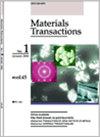Ti-Pd合金在过氧化氢中的表面结构和加氢性能
IF 1.9
4区 材料科学
Q4 MATERIALS SCIENCE, MULTIDISCIPLINARY
引用次数: 0
摘要
本研究采用双氧水作为绿色脱合金方法,实现了Ti-Pd合金表面Pd浓度的增加,并确定了Pd对Ti-Pd合金加氢的影响。Ti - Pd合金中Ti的自发氧化可在表面析出低价Pd,可用于快速生成δ-TiH2并作为各种有机反应的催化剂。另一方面,自发氧化对提高表面Pd浓度的潜力有限。由于大部分Pd仍在金属相中,因此需要提高剩余Pd的利用率。已知H2O2是一种绿色氧化剂,也与Ti形成配合物,因此预计通过合金化可以富集表面Pd。研究了H2O2浸泡加氢对Ti-Pd合金表面性能的影响。结果表明,H2O2浸泡可使Ti - Pd合金的氧化层厚度增加,Pd浓度增加。在片状试样上进行的模型实验表明,Ti氧化物层阻碍了氢的扩散,而表面的Pd具有增加氢向金属相供应的作用。表面Pd对H2O2的快速分解也有影响。这些结果表明,H2O2浸泡可以有效地提高表面Pd浓度,同时减少Ti的溶解。本文章由计算机程序翻译,如有差异,请以英文原文为准。
Surface Structures and Hydrogenation Properties of Ti–Pd Alloys Immersed in Hydrogen Peroxide
This study achieves an increase in Pd concentration on the surface of Ti–Pd alloys using hydrogen peroxide as a green dealloying method, as well as determining the effect of Pd on the hydrogenation of the Ti–Pd alloys. Spontaneous oxidation of Ti in Ti–Pd alloys has been reported to precipitate low-valent Pd on the surface, which can be used for fast δ-TiH2 formation and as a catalyst for various organic reactions. On the other hand, spontaneous oxidation has limited potential to increase the surface Pd concentration. As most of the Pd remains in the metallic phase, there is a need to increase the utilization of the remaining Pd. H2O2 is known to be a green oxidant and also forms complexes with Ti, therefore surface Pd enrichment by dealloying is expected. This study was carried out to investigate the relationship between hydrogenation and surface properties of Ti–Pd alloys by H2O2 immersion. The increase in the thickness of Ti oxide layers and the increase in Pd concentration on Ti–Pd alloys were found by H2O2 immersion. Model experiments on chip-like specimens showed that the Ti oxide layer retards hydrogen diffusion, while the Pd on the surface has the effect of increasing the hydrogen supply to the metallic phase. Pd on the surface was also found to have an effect on the fast decomposition of H2O2. These results indicate that H2O2 immersion is effective as a surface treatment to increase the Pd concentration on the surface with reduced Ti dissolution.
求助全文
通过发布文献求助,成功后即可免费获取论文全文。
去求助
来源期刊

Materials Transactions
工程技术-材料科学:综合
CiteScore
2.00
自引率
25.00%
发文量
205
审稿时长
2.7 months
期刊介绍:
Information not localized
 求助内容:
求助内容: 应助结果提醒方式:
应助结果提醒方式:


